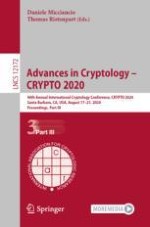2020 | OriginalPaper | Chapter
Fiat-Shamir for Repeated Squaring with Applications to PPAD-Hardness and VDFs
Authors : Alex Lombardi, Vinod Vaikuntanathan
Published in: Advances in Cryptology – CRYPTO 2020
Publisher: Springer International Publishing
Activate our intelligent search to find suitable subject content or patents.
Select sections of text to find matching patents with Artificial Intelligence. powered by
Select sections of text to find additional relevant content using AI-assisted search. powered by
